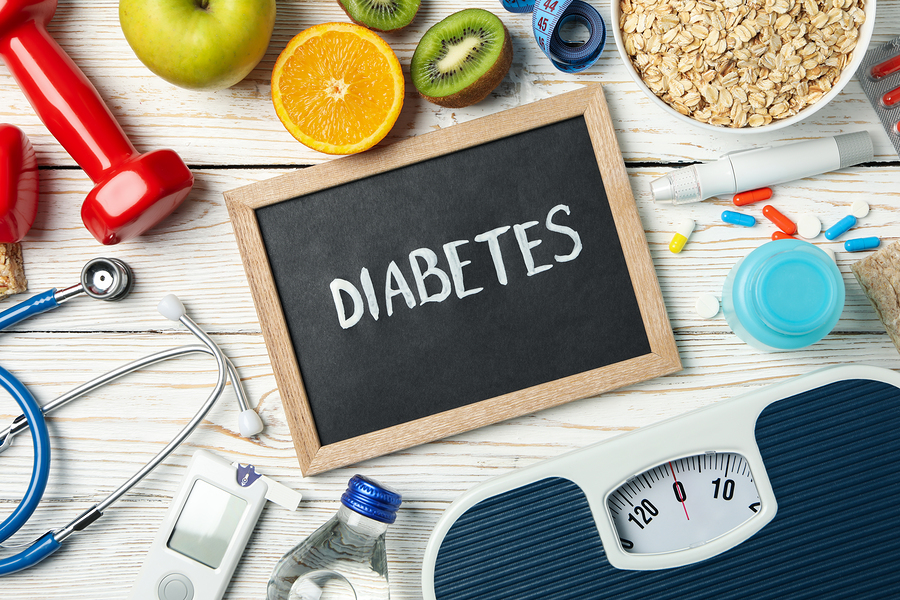How to recognise, diagnose and manage diabetes
What causes diabetes? How do we recognise the symptoms? How important is diet and lifestyle in managing type 2 diabetes?
The number of people living with diabetes in the UK is increasing year on year. Including those cases that remain undiagnosed, Diabetes UK estimates there are 4.6 million of us living with the condition. 90% of all cases are linked with obesity and diabetes is fast becoming one of the most common long term health conditions in the world.
But this is one condition we can do something about. Type 2 diabetes can be managed and even reversed by making healthier lifestyle choices. So it is hugely important for all of us to understand diabetes so we can learn what to do to help ourselves, family or friends.
Some of your questions are answered by Hema Love, a pharmacist in our Health at Hand team:
Can you tell us what exactly diabetes is?
Insulin is a hormone in our body that helps move glucose – a type of sugar – out of the blood and into our cells where it is converted into energy. Diabetes occurs when our body is unable to use the insulin it produces as well as it should or when it doesn’t produce enough insulin in the first place. This lack of insulin (or resistance to its effects) causes a build-up of glucose in the blood.
In a person without diabetes, the pancreas, which releases the insulin, will detect when glucose is in the bloodstream and will release just the right amount of insulin to maintain the level of glucose. Glucose levels in the blood will also be topped up from reserves in the body if levels fall too low.
However, if you have diabetes then this system is not working as it should and if left uncontrolled then it could lead to serious conditions such as kidney failure, heart disease and even blindness.
I don’t understand the difference between type 1 and type 2 diabetes – which is more serious?
High blood sugar along with symptoms you may be experiencing will form the basis of a diabetes diagnosis for both type 1 and type 2. Type 1 diabetes usually starts during the childhood or teenage years and is treated with insulin injections.
Diabetes is said to be type 1 when the body produces no insulin. Type 2 diabetes is when the body does not produce enough insulin or when the cells in the body don’t react to insulin as they should (insulin resistant).
Both type 1 and type 2 diabetes are diagnosed on the basis of your blood sugar being too high, together with the symptoms you are experiencing.
Type 1 diabetes tends to start earlier in life (usually in childhood or teenage years) and has to be treated with insulin injections from the outset.
Type 2 diabetes tends to occur in adulthood and is associated with being overweight. It can also run in families. Often, especially in the early stages, type 2 diabetes can be successfully treated with diet and tablets.
As serious health conditions can result if both types of diabetes are left uncontrolled it is extremely important to have regular treatment.
What are ‘normal’ blood sugar levels?
It is crucial for diabetics (both type 1 and type 2) to monitor their blood sugar levels regularly if they are being treated with insulin as it is important they remain stable.
The way we measure blood sugar is by millimols per litre (mmol/1). Diabetes UK state that diabetics should have blood sugar levels as follows:
- Type 2 adult diabetes: 4 to 7 mmol/1 before meals, less than 8.5 mmol/1 two hours after meals.
- Type 1 diabetes: 5 to 6 mmol/l on waking, 4 to 7 mmol/l before meals, 5 to 9 mmol/l 90 minutes after meals.
Click here to see a handy guide from Diabetes UK on how to manage your diabetes.
In order to test for diabetes, blood sugar levels are normally taken after eight hours of fasting. The range is as follows:
- 70 to 100mg/dl (5.6mmol/l) indicates a normal range
- 101 to 126mg/dl (5.6 to 7mmol/l) indicates pre-diabetes or impaired glucose tolerance
- more than126mg/dl (7mmol/l) indicates diabetes.
What is the importance of blood sugar levels?
Hypoglycaemia can result if blood sugar levels are too low. A reading below 3.9 is said to be ‘hypo’.
If you are diabetic and you miss a meal, exercise too vigorously or drink alcohol on an empty stomach then a ‘hypo’ may be triggered. Similarly, some diabetic medication can lower blood sugar resulting in a ‘hypo’ too.
On the other hand, hyperglycaemia can result if blood sugar levels are too high. This can result in severe dehydration.
How would I recognise diabetic symptoms?
Type 1 diabetes often comes on very quickly with symptoms such as:
- extreme tiredness
- unexplained weight loss
- blurred vision
- polydipsia (constant thirst)
- polyuria (producing and passing urine more frequently).
As type 2 diabetes is often linked with diet it is slower to develop. Symptoms may include:
- extreme tiredness
- blurred vision
- increased hunger (or still feeling hungry after a meal)
- increased thirst
- polyuria (producing and passing urine more frequently)
- cuts, bruises, wounds take much longer to heal
- women – repeated vaginal thrush
- men – itching around the genital area.
Is there any cure?
Unfortunately, at present there is no cure for diabetes but it can be controlled.
Type 1 diabetics take insulin every day, either by injection or through a pump which drip feeds the insulin into the body.
Type 2 diabetics can control their diabetes through diet and exercise although they may be required to take medication, or inject insulin, as the condition progresses.
I’ve heard of prediabetes – what does this mean?
Prediabetes is the term used when you are at risk of developing type 2 diabetes – your blood glucose levels are raised but not high enough to qualify as diabetes.
Changes in diet and being more active can, in many cases, delay or even prevent the onset of diabetes itself.
Are there links between Glucose Fructose Syrup (HFCS) and diabetes in younger people?
The majority of children and young people with diabetes have type 1 which is not linked to diet. Although there are a growing number of children being diagnosed with type 2 diabetes, a link with the consumption of fructose has not been proven. Further research is needed.
Click here to learn more about HFCS and diabetes
I have been told I am at risk of type 2 diabetes but although I am following a diet with reduced salt and sugar and take regular exercise my weight, waist size and BMI have stayed the same. What else can I do?
If you are following a calorie-reduced diet, exercising at least 30 minutes per day and you are not seeing any change in your waistline or BMI then it would be sensible to see your GP as there may be an underlying condition that is affecting you.
I am aware the recommended daily intake of sugar is 90 grams but does the sugar in honey and fruit count?
All sugars count towards the 90 gram recommendation, including fruit sugars.
I take exercise but is there anything else I should do?
Alongside exercise, maintaining a healthy weight for your height is recommended. Eat a healthy, balanced diet and avoid long periods of sitting such as at a desk or watching TV. If you are pre-diabetic or have diabetes, it is sensible to cut down on sugary, fizzy drinks too as these will result in a rush of glucose which your body finds difficult to cope with.
Can feet be affected by diabetes?
Those with diabetes do tend to have problems with their feet as raised blood sugars can affect sensation and circulation.
There are two complications that are specific to feet. These are, peripheral arterial disease (poor circulation to the feet) and peripheral neuropathy (nerve damage). Signs can include:
- cracked, split or broken skin – this can lead to infection
- numbness – this may mean that an injury or even sores from a badly fitting shoe may not felt and so may lead to infection
- thickened, hard skin in areas of pressure – this can lead to damage of underlying tissues
A yearly foot care check will be offered to you if you have diabetes.
What happens if you’re pregnant and then diagnosed with diabetes?
Diabetes during pregnancy is called gestational diabetes. Usually, the mother’s blood glucose levels return to normal after the baby is born and blood tests will be undertaken to ensure this has happened. However, those women who have suffered gestational diabetes are more prone to develop it again in subsequent pregnancies and to developing type 2 diabetes later in life.
If diabetes is diagnosed later in life is it worse for you?
How you cope with either type 1 or type 2 diabetes is determined by your general health and other medical conditions you may have. However, the older we become the more likely we are of having other medical conditions that could potentially be made worse by diabetes.
My type 2 diabetes has progressed over the years. I initially controlled it with tablets but I now have to take insulin injections. Does this now make me a type 1 diabetic?
It would seem that your diabetes has developed and your body is now either not producing enough insulin or it is unable to use the insulin effectively. However, you are still classed as a type 2 diabetic even though you require insulin injections to keep your glucose levels under control.
We recommend that you make an appointment with your doctor for an exact diagnosis to clarify this for you.
For more information on how to help yourself or a loved one, visit our Diabetes centre
Disclaimer
All content on Silversurfers.com is provided for general information only, and should not be treated at all as a substitute for the medical advice of your own doctor or any other health care professional. Silversurfers will not be responsible or liable for any diagnosis made by a user based on the content on www.silversurfers.com and we are also not liable for the content of any external websites or links from or to Silversurfers to any other websites. Please always consult your own doctor if you’re in any way concerned about any aspect of your health
Melina - Assistant Editor
Latest posts by Melina - Assistant Editor (see all)
- By yourself at Christmas this year? Tips on how to manage alone - December 16, 2024
- The Silversurfers, just for fun, Christmas Quiz! - December 14, 2024
- 10 potential hazards for pets at Christmas - December 10, 2024
- Christmas Spiced Blueberry Panettones - December 1, 2024
- Three must have toys of the late 60’s - November 24, 2024




















